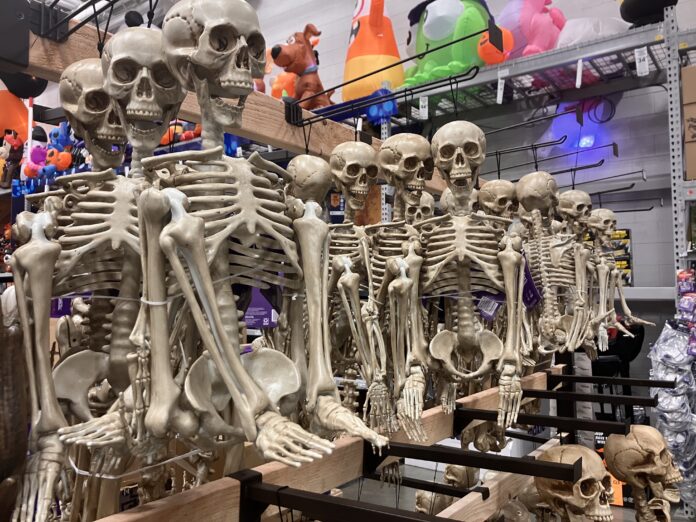Halloween brings joy to the faces of children, families and partygoers, but it doesn’t bring joy to thrift stores and landfills. Halloween is a holiday that encourages wasteful consumption, but at the same time, the holiday is expected to generate $12 billion in 2023, according to the National Retail Foundation. Halloween is one of the many American traditions subject to the age-old argument between sustainability and economic impact. Is Halloween and its economic impact worth the waste it generates? With Halloween celebrations on the way, what do UNLV students and faculty think about Halloween, its economic impact, consumerism and waste?
Anthony Rojas, a marketing student and one of UNLV’s Economic Club’s event coordinators, says, “From a microeconomics standpoint, demand is so high during Halloween because everyone wants costumes and candies … Spending more means stimulating the economy, and that’s the main aspect of Halloween. A holiday like this incentivizes people to spend.” Elijah Brown, a finance major and one of the event coordinators of UNLV’s Economics Club, shares, “Halloween increases consumer spending … In economic terms, it stimulates the short-term economy and that can have a lot of benefits.” However, Brown concedes that overconsumption is something that should be addressed. Brown says, “Could you argue that it is wasteful? Does that outweigh the economic benefits? Absolutely, you could argue that … If you’re going out and you’re spending a lot of money, for example, if you buy a 8-foot skeleton, that’s probably not the best idea, not the smartest way of doing that.”
Tara Pike is UNLV’s Sustainability Coordinator, Recycling Manager and one of the architects of UNLV’s Climate Action Plan. Pike shares that, along with Christmas, Halloween is one of the most wasteful holidays. Pike points out how pumpkins are bought, only to be carved instead of eaten as food. According to Columbia Daily Tribune, pumpkin growing is an economy worth $150 million, and 98% of the pumpkins used are used as decorations. Pike says, “People should be looking to see what they can do with their pumpkins after Halloween. There’s a lot of animal rescue groups that would love the pumpkins … Feeding the animals is a fantastic thing to do and also composting it, rather than throwing it into a landfill. In a landfill, all those pumpkins are slowly degrading anaerobically because there’s no oxygen in landfills. Because the bacteria in landfills are anaerobic, they’re the ones that give off methane, a powerful greenhouse gas.” Carved pumpkins are best composted, as they wouldn’t be able to be consumed.
Halloween season also brings the elaborate decorations homeowners put out. Pike says, “Obviously, with dollar stores, so much is just breakable junk that you use once and throw away.”
Anthony Hernandez, President of UNLV’s Economic Club, shares the reasoning behind why companies make Halloween items that aren’t durable. “You’ll go into a Spirit Halloween and the costumes will be barebones and made of the worst material, like it’ll be uncomfortable and super thin, all for $60 … And they do it to make as much profit as they possibly can, to capitalize on it right now. They have to make all their profits for the year in one month.”
Nicholas Irwin, an economics professor at UNLV who studies the environmental economic activity of homeowners’ decision-making, shares, “That’s always a complaint, that things are made to be replaced because they’re so cheap. That is an issue we have with our economic activity. Things are, relative to 10 or 15 years ago, so much cheaper than they were, so it’s easier to replace them. From a business perspective, they’re motivated by maximizing profits. But you hope that, if companies are doing that, they’re not rewarded as companies that make much more durable and long-lasting products. You can also get repeat customers for things that last a long time instead of buying the same cheap dollar store decorations that barely make it to Halloween. If decorations are a little bit nicer, then you’ll decide, ‘Oh, I need to buy decorations for another holiday from the same company because I know its a good product.’”
Halloween can and should be thought of as a holiday that can be celebrated sustainably and mindfully. “A lot of companies are practicing sustainability. In Spirit Halloween, they have those animatronics, and people buy them to keep long term,” Rojas adds. Rojas thinks that Halloween can be practiced more sustainably if a lot more companies promote sustainable decor instead of single-use decor. Pike agrees, saying, “With decorations, you should look for things you can keep, store and put out as your decorations.”
What happens to the costume after you wear it to a Halloween party? Do you keep it? Donate it? Unfortunately, donating is not enough. According to the University of Colorado Boulder’s Environmental Center, 84% of donated clothing still end up in landfills and incinerators. The most sustainable way to dress up for Halloween is to refuse to buy new costumes and decorations. If you do buy costumes, it should be an article of clothing that can be kept and re-worn (either in a day-to-day wardrobe or for Halloween in years to come). Pike says, “With Halloween, one of the great things I’ve seen is people making costumes from thrifted items.” It can also be a relief to not have to plan different costumes for every Halloween party or celebration. “I thrift really often and I reuse my costume. I don’t like buying new costumes,” Hernandez jokes.
Although Halloween is not a holiday where most people think of their environmental impact, a major shift in how consumers think of Halloween is still needed. Not only can a shift in behavior for companies and consumers keep waste out of landfills, but it can also make the environment hospitable enough for Halloween to be a tradition that is enjoyed for years to come.

